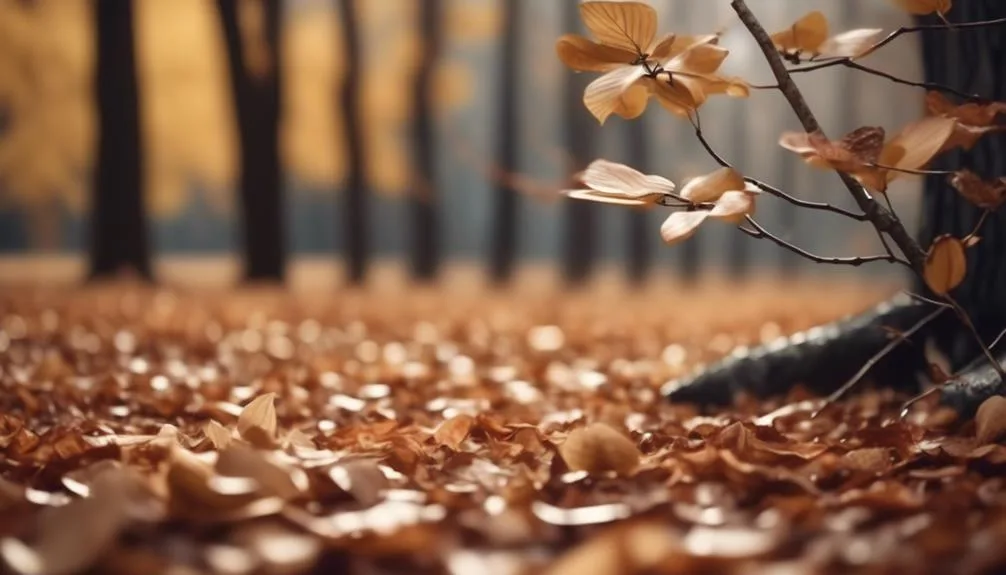Dogwood trees are known for their stunning beauty, but have you ever wondered why they shed leaves early? Understanding if this is normal is vital for their care.
There are key factors to consider when it comes to leaf drop in dogwood trees. Recognizing these factors can help you determine if it's a natural process or if there's an underlying issue.
Knowing more about leaf drop in dogwood trees can help you better care for them in your landscape.
Signs of Normal Leaf Drop in Dogwood Trees
As autumn approaches, you may notice the dogwood trees in your yard shedding their leaves, but don't be alarmed – this is a normal part of their seasonal cycle. Dogwood trees naturally undergo leaf drop as the days grow shorter and temperatures cool. Seasonal changes trigger this process, and it's essential for the tree's health.
However, if the leaf drop seems excessive or happens at unexpected times, it could indicate a nutrient deficiency or environmental stress. Keep an eye out for signs of insect infestation, as certain pests can also cause premature leaf drop.
To support your dogwood tree through this natural process, ensure it receives proper nutrients, water, and appropriate care. If you suspect something more serious than normal leaf drop, consulting with a professional arborist can help identify and address any underlying issues.
Factors Affecting Leaf Drop in Dogwood Trees
If you've noticed a significant amount of leaves dropping from your dogwood trees at unexpected times, it's crucial to understand the various factors that can influence this process. Environmental factors and seasonal changes play a significant role in leaf drop. Sudden temperature fluctuations, extended periods of drought, or excessive rainfall can trigger early leaf shedding. Additionally, soil conditions and nutrient deficiencies can impact the health of your dogwood trees. Poor drainage, compacted soil, or nutrient imbalances can lead to stress and ultimately cause leaves to drop prematurely. Understanding these factors can help you address any issues and promote the overall well-being of your dogwood trees.
| Factors Affecting Leaf Drop | Impact |
|---|---|
| Environmental factors | Seasonal changes |
| Soil conditions | Nutrient deficiencies |
Identifying Abnormal Leaf Drop in Dogwood Trees
To identify abnormal leaf drop in your dogwood trees, closely inspect the pattern and timing of the leaf shedding, and consider any recent changes in environmental conditions or tree health.
Early and abnormal leaf drop in dogwood trees can be identified by observing the timing of leaf shedding. If leaf drop occurs before the fall season or shortly after leaves have emerged in spring, it may indicate an issue.
Additionally, pay attention to any signs of abnormal discoloration in the leaves, such as unusual yellowing, browning, or spotting.
Changes in environmental conditions, such as sudden temperature fluctuations or prolonged drought, can also contribute to abnormal leaf drop.
Keep an eye out for any recent stressors that might've affected the overall health of your dogwood tree, as this could be a sign of abnormal leaf shedding.
Managing Leaf Drop in Dogwood Trees
Examine any underlying factors contributing to abnormal leaf drop in your dogwood trees and implement effective strategies to manage and mitigate this issue.
Proper pruning techniques can help maintain the health of your dogwood trees and reduce leaf drop. Regularly inspect your trees for dead, diseased, or crossing branches, and prune them during the dormant season to promote air circulation and sunlight penetration.
Additionally, ensure a consistent watering schedule, especially during dry periods, to keep the soil evenly moist but not waterlogged. Deep watering less frequently is preferable to frequent shallow watering.
Consider applying a layer of mulch around the base of the trees to help retain moisture and regulate soil temperature.
Seeking Professional Help for Dogwood Tree Leaf Drop
Consider consulting with a certified arborist or horticulturist to accurately diagnose and address the leaf drop issue in your dogwood trees. Professional consultation is crucial for understanding the underlying causes of the leaf drop and developing an effective plan to restore your tree's health.
An experienced arborist can assess the overall health of your dogwood trees, identify any diseases or pests, and recommend appropriate treatments. They can also provide valuable insights into environmental factors that may be contributing to the leaf drop, such as soil conditions, watering practices, or sunlight exposure.
Conclusion
In summary, monitoring your dogwood tree for any signs of abnormal leaf drop is crucial for its health.
Understanding the factors affecting leaf drop and providing proper care will help maintain its vitality.
If you have concerns, seek professional assessment to ensure the tree's well-being.

My interest in trees started when I first saw the giant sequoias in Yosemite.
I was a teenager then, and I remember thinking, “I need to learn more about this.”
That moment stuck with me.
A few years later, I went on to study forestry at Michigan Tech.
Since graduating, I’ve worked in a mix of hands-on tree care and community education.
I’ve spent over ten years helping people understand how to plant, maintain, and protect the trees in their neighborhoods.
I don’t see trees as just part of the landscape.
They are living things that make a real difference in our daily lives.
